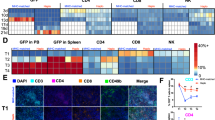Abstract
Graft-versus-host disease (GVHD) results from immunemediated attacks on recipient tissues by donor-originated cells through the recognition of incompatible antigens expressed on host cells. The pre-conditioning irradiation dose is a risk factor influencing GVHD severity. In this study, using newly generated luciferase transgenic mice on a B6 background (B6.LucTg) as bone marrow and splenocyte donors, we explored the effects of irradiation doses on donor cell dynamics in major histocompatibility complex (MHC)-matched allogeneic GVHD hosts via bioluminescence imaging (BLI). Results from BLI of GVHD hosts showed higher emission intensities of luminescence signals from hosts irradiated with 900 cGy as compared with those irradiated with 400 cGy. In particular, BLI signals from target organs, such as the spleen, liver, and lung, and several different lymph nodes fluctuated with similar time kinetics soon after transplantation, reflecting the synchronous proliferation of donor cells in the different organs in hosts irradiated with 900 cGy. The kinetic curves of the BLI signals were not synchronized between the target organs and the secondary organs in hosts irradiated with 400 cGy. These results demonstrate that pre-conditioning doses influence the kinetics and degree of proliferation in the target organs soon after transplantation. The results from this study are the first describing donor cell dynamics in MHC-matched allogeneic GVHD hosts and the influence of irradiation doses on proliferation dynamics, and will provide spatiotemporal information to help understand GVHD pathophysiology.
Similar content being viewed by others
References
Beilhack, A., Schulz, S., Baker, J., Beilhack, G.F., Wieland, C.B., Herman, E.I., Baker, E.M., Cao, Y.A., Contag, C.H., and Negrin, R.S. (2005). In vivo analyses of early events in acute graftversus-host disease reveal sequential infiltration of T-cell subsets. Blood 106, 1113–1122.
Beilhack, A., Schulz, S., Baker, J., Beilhack, G.F., Nishimura, R., Baker, E.M., Landan, G., Herman, E.I., Butcher, E.C., Contag, C.H., et al. (2008). Prevention of acute graft-versus-host disease by blocking T-cell entry to secondary lymphoid organs. Blood 111, 2919–2928.
Cao, Y.A., Bachmann, M.H., Beilhack, A., Yang, Y., Tanaka, M., Swijnenburg, R.J., Reeves, R., Taylor-Edwards, C., Schulz, S., Doyle, T.C., et al. (2005). Molecular imaging using labeled donor tissues reveals patterns of engraftment, rejection, and survival in transplantation. Transplantation 80, 134–139.
Choi, E.Y., Yoshimura, Y., Christianson, G.J., Sproule, T.J., Malarkannan, S., Shastri, N., Joyce, S., and Roopenian, D.C. (2001). Quantitative analysis of the immune response to mouse non-MHC transplantation antigens in vivo: the H60 histocompatibility antigen dominates over all others. J. Immunol. 166, 4370–4379.
Choi, E.Y., Christianson, G.J., Yoshimura, Y., Jung, N., Sproule, T.J., Malarkannan, S., Joyce, S., and Roopenian, D.C. (2002a). Real-time T-cell profiling identifies H60 as a major minor histocompatibility antigen in murine graft-versus-host disease. Blood 100, 4259–4265.
Choi, E.Y., Christianson, G.J., Yoshimura, Y., Sproule, T.J., Jung, N., Joyce, S., and Roopenian, D.C. (2002b). Immunodominance of H60 is caused by an abnormally high precursor T cell pool directed against its unique minor histocompatibility antigen peptide. Immunity 17, 593–603.
Choi, J.H., Yoon, H., Min, C.K., and Choi, E.Y. (2011). Effects of pre-conditioning dose on the immune kinetics and cytokine production in the leukocytes infiltrating GVHD tissues after MHC-matched transplantation. Immun. Netw. 11, 68–78.
Ferrara, J.L., Levy, R., and Chao, N.J. (1999). Pathophysiologic mechanisms of acute graft-vs.-host disease. Biol. Blood Marrow Transplant 5, 347–356.
Ferrara, J.L., Levine, J.E., Reddy, P., and Holler, E. (2009). Graftversus-host disease. Lancet 373, 1550–1561.
Korngold, R., and Wettstein, P.J. (1990). Immunodominance in the graft-vs-host disease T cell response to minor histocompatibility antigens. J. Immunol. 145, 4079–4088.
Murai, M., Yoneyama, H., Ezaki, T., Suematsu, M., Terashima, Y., Harada, A., Hamada, H., Asakura, H., Ishikawa, H., and Matsushima, K. (2003). Peyer’s patch is the essential site in initiating murine acute and lethal graft-versus-host reaction. Nat. Immunol. 4, 154–160.
Negrin, R.S., and Contag, C.H. (2006). In vivo imaging using bioluminescence: a tool for probing graft-versus-host disease. Nat. Rev. Immunol. 6, 484–490.
Panoskaltsis-Mortari, A., Price, A., Hermanson, J.R., Taras, E., Lees, C., Serody, J.S., and Blazar, B.R. (2004). In vivo imaging of graft-versus-host-disease in mice. Blood 103, 3590–3598.
Rabinovich, B.A., Ye, Y., Etto, T., Chen, J.Q., Levitsky, H.I., Overwijk, W.W., Cooper, L.J., Gelovani, J., and Hwu, P. (2008). Visualizing fewer than 10 mouse T cells with an enhanced firefly luciferase in immunocompetent mouse models of cancer. Proc. Natl. Acad. Sci. USA 105, 14342–14346.
Roopenian, D., Choi, E.Y., and Brown, A. (2002). The immunogenomics of minor histocompatibility antigens. Immunol. Rev. 190, 86–94.
Shlomchik, W.D. (2007). Graft-versus-host disease. Nat. Rev. Immunol. 7, 340–352.
Shlomchik, W.D., Couzens, M.S., Tang, C.B., McNiff, J., Robert, M.E., Liu, J., Shlomchik, M.J., and Emerson, S.G. (1999). Prevention of graft versus host disease by inactivation of host antigen-presenting cells. Science 285, 412–415.
Thomson, A.W., and Knolle, P.A. (2010). Antigen-presenting cell function in the tolerogenic liver environment. Nat. Rev. Immunol. 10, 753–766.
Ushiki, T., Kizaka-Kondoh, S., Ashihara, E., Tanaka, S., Masuko, M., Hirai, H., Kimura, S., Aizawa, Y., Maekawa, T., and Hiraoka, M. (2010). Noninvasive tracking of donor cell homing by nearinfrared fluorescence imaging shortly after bone marrow transplantation. PLoS One 5, e11114.
Weissleder, R., and Pittet, M.J. (2008). Imaging in the era of molecular oncology. Nature 452, 580–589.
Yoon, S.R., Chung, J.W., and Choi, I. (2007). Development of natural killer cells from hematopoietic stem cells. Mol. Cells 31, 1–8.
Zhang, Y., Shlomchik, W.D., Joe, G., Louboutin, J.P., Zhu, J., Rivera, A., Giannola, D., and Emerson, S.G. (2002). APCs in the liver and spleen recruit activated allogeneic CD8+ T cells to elicit hepatic graft-versus-host disease. J. Immunol. 169, 7111–7118.
Author information
Authors and Affiliations
Corresponding authors
Additional information
These authors contributed equally to this work.
About this article
Cite this article
Song, M.G., Kang, B., Jeon, J.Y. et al. In Vivo imaging of differences in early donor cell proliferation in graft-versus-host disease hosts with different pre-conditioning doses. Mol Cells 33, 79–86 (2012). https://doi.org/10.1007/s10059-012-2228-y
Received:
Revised:
Accepted:
Published:
Issue Date:
DOI: https://doi.org/10.1007/s10059-012-2228-y




